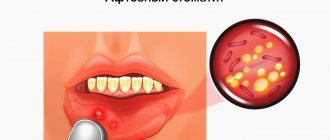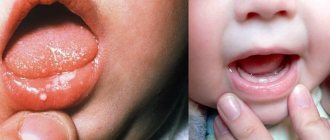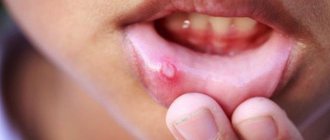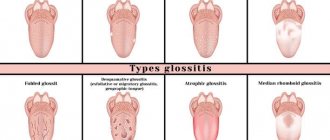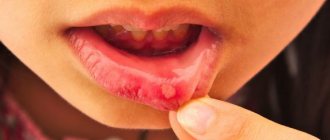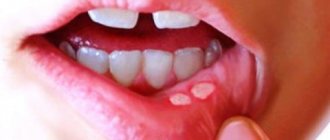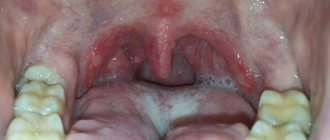Infectious and inflammatory diseases of the oral cavity are often diagnosed in children. Doctors explain this by insufficient hygiene in childhood and the incomplete formation of the immune system.
In this case, it is necessary to distinguish between dangerous infections and benign inflammatory processes. Thus, temperature during stomatitis in children may indicate the infectious nature of the disease.
Causes of stomatitis
The imperfection of local and general defenses of the child’s body makes the mucous membranes of the oral cavity vulnerable to adverse factors. And the healthy curiosity characteristic of every child has made stomatitis one of the most common diseases among children. Sometimes, for the development of an illness, it is enough to taste any less than sterile object. The main causes of the disease include the following:
- insufficiently good oral hygiene;
- minor injuries - cheek biting, scratch, etc.;
- burns, including chemical burns;
- exposure to pathogens from unwashed hands or dirty toys.
Dentists focus on stomatitis associated with biting the inside of the cheek.
This is often associated with recent dental treatment under local anesthesia. For some time after the procedure, there is reduced sensitivity in the area of the lip or cheek, so you need to eat food after treatment very carefully and only after you have waited for the recommended period of time - usually from 1 to 2 hours. The likelihood of developing stomatitis for these reasons increases after infectious diseases, previous interventions, hypothermia and other factors that contribute to a decrease in protective forces.
Classification and forms of aphthous stomatitis
According to the nature of the disease, stomatitis can be:
- Spicy . The appearance of painful ulcers in the mouth is accompanied by fever. The disease lasts 2–3 weeks;
- Chronic . The disease progresses in waves, with periods of long lulls and rare exacerbations. Lasts up to 2–3 years.
According to the type of pathogen, stomatitis is:
- Viral . Its causative agent is the herpes virus. It causes bubbles of clear liquid to appear. After the bubbles burst, aphthae remain in their place.
- Radial . If the mucous membrane is irradiated by ionizing radiation, compactions and erosions may occur.
- Fungal . Occurs when immunity decreases or a shock dose of antibiotics. A powdery coating forms on the seals of the mucous membrane, and when you try to remove it, the aphthae is exposed.
- Bacterial . Caused by streptococci and staphylococci. The whole process goes quickly - ulcers are actively formed, aphthae quickly stop hurting and heal.
- Chemical . This is the result of burns to the mouth from acids or alkalis. In this case, deep ulcers are formed and the tissue is deformed.
Depending on the type of pathogen, several forms of acute stomatitis are distinguished:
- Fibrinous. In the initial stage, rashes appear no more than 1–3 times a year during exacerbations of systemic diseases or microtraumas of the mouth. Small blisters covered with fibrous plaque are located on the inner surface of the lips, tongue, and cheeks. They scar after 1–2 weeks. If the cause of the disease is not treated, aphthae form more and more often and cover large areas.
- Necrotic. Typical for patients suffering from severe chronic pathologies. In this case, aphthae become a consequence of the death of the epithelium. In the initial stage, aphthae are painless, but then develop into ulcers that do not close within a period of several weeks to a month.
- Gradular . It develops when the salivary glands are damaged, and aphthae develop next to them. The ulcers are painful and take 1 to 3 weeks to heal, after which the ulcers reopen.
- Scarring. Aphthae cover the mucous membrane of the mouth near the salivary glands, pharynx and palate. At first they are small in size, but quickly unite into deep painful ulcers with a diameter of up to 1 centimeter. They heal slowly (up to 3 months) and form scars.
- Deforming. The most severe form of aphthous dermatitis. Aphthae grow deeply into the mucous membrane and, when healing, form rough scars that deform the oral cavity. Deforming stomatitis is the most difficult to treat; recovery will take at least 2 months.
- Herpetic . Consequence of infection by the herpes virus. Up to 30 small ulcers simultaneously form on the mucous membrane, the tissues become inflamed and turn bright red. It is more common in infants who become infected with the virus in utero or during childbirth.
- Recurrent . Aphthae do not heal for a long time, merge with each other and form a large painful ulcer. The lesions become covered with a white coating, make it difficult to eat, and the person suffers from pain and burning. This form of stomatitis occurs only in adults.
In children, 2 forms are most often observed:
- Spicy . Children under 3 years old are ill, usually against the background of other infectious diseases - whooping cough, diphtheria, measles. In acute stomatitis, a lot of saliva is released, the smell from the mouth is unpleasant, putrefactive.
- Mixed. They appear in children over 4 years of age and cause frequent relapses. In this case, the disease affects an increasingly larger area each time.
Types of stomatitis
The treatment regimen for stomatitis in children is based on the type of disease. There are several types of stomatitis:
- bacterial;
- viral, including herpes;
- fungal;
- aphthous;
- angular;
- allergic;
- traumatic.
All types of stomatitis occur in children, but the most common among children under 3 years of age are aphthous, candidal, herpetic and allergic. An increase in the incidence of traumatic stomatitis is usually associated with a period of active growth of primary teeth.
It is important to understand that in some cases, stomatitis is combined with other diseases with similar symptoms and is the first sign of more serious diseases. For example, with cheilitis - inflammation of the mucous membrane and red border of the lips, food allergies, etc.
Symptoms
Common symptoms of stomatitis are pain, burning, swelling of the mucous membrane and redness, and bad breath. Salivation also changes - it can be excessive or insufficient, with dry mouth. In some cases, there may be an increase in temperature and enlargement of the submandibular lymph nodes.
The types of stomatitis in children and treatment methods differ, as do the specific manifestations. For example, with aphthous stomatitis, only one large ulceration may appear, but with viral stomatitis, inflammation almost always takes the form of numerous elements or a rash merging into one focus.
Candidal stomatitis is characterized by the formation of a white or yellowish cheesy coating. It is easier to recognize traumatic stomatitis because it is preceded by damage or the source of injury is nearby - a chipped tooth or a rough filling.
Symptoms of aphthous stomatitis and its complications
Aphthous stomatitis does not begin with the formation of ulcers. The stages of the disease are:
- The lymph nodes become inflamed, the temperature rises and general weakness occurs.
- Small blisters form in the mouth, which spontaneously open and turn into aphthae.
- Salivation increases.
- At first, it is unpleasant for the patient to eat food with a pronounced taste, and then chewing any food causes pain.
- With a persistent form of aphthous stomatitis, the lymph nodes become inflamed and become painful on palpation.
- The mucous membranes of the mouth are loose and inflamed.
- A white coating appears on the tongue.
- At the final stage of the disease, aphthae scar, and soreness in the mouth disappears.
If the patient has not received adequate treatment, aphthous stomatitis becomes chronic. Wherein:
- The mucous membranes swell and turn pale.
- Aphthae grow and cover the inner surface of the cheeks, palate and back of the tongue. In advanced forms, the ulcers rise above the surface of the oral mucosa.
- Without receiving proper treatment, the growth of ulcers resumes every two weeks. The wounds bleed and penetrate deeper into the tissues of the mouth.
- When healing, erosions leave deep scars.
Diagnostic features
A dentist can detect stomatitis during the first visual examination. But in controversial cases, laboratory tests may be required. Thus, bacterial inflammation may require identification of the causative agent of the disease and its sensitivity to antibiotics. A scraping and/or virological study will help determine the cause of the disease and prescribe appropriate treatment.
If a combination of several ailments with a similar picture is suspected, as well as if the child’s general well-being deteriorates, laboratory tests of blood and urine and consultations with other specialists may be prescribed.
Sometimes stomatitis can be the first manifestation of systemic diseases, general somatic pathology, for example, diabetes mellitus or malignant neoplasms. Therefore, a timely visit to the doctor is extremely important.
Features of treatment
As is often the case with diseases that are at the intersection of several areas of medicine, inflammatory lesions of the oral mucosa are one of the least studied areas of dentistry. Therefore, several specialists can be involved in the treatment of stomatitis in children in the mouth: pediatrician, dentist, dermatologist, immunologist-allergist, otolaryngologist, etc. This is especially convenient when you go to a multidisciplinary clinic.
Self-medication of stomatitis is unacceptable, and although it is now easy to find ready-made treatment regimens and folk recipes, it is important not to experiment with the baby’s health.
Conservative treatment is mainly used, which involves treating the underlying cause of the disease. Your doctor may prescribe the following medications:
- antibacterial drugs (systemic and local in the form of ointments): for bacterial inflammation;
- antiviral agents for herpes and other types of viral stomatitis;
- antifungal drugs for fungal diseases;
- antihistamines - both for allergic origin of stomatitis, and as part of complex therapy to reduce swelling and itching;
- symptomatic drugs - anti-inflammatory, analgesic, antipyretic.
Treatment of candidal stomatitis in infants should be carried out with caution. At the same time, it is important to pay attention to your health; sometimes the cause of such a disease can be insufficient breast hygiene during lactation.
Often, only local remedies are sufficient, but make sure that the entire oral cavity is treated with the rinse - inflammatory agents can be found on the entire surface of the mucous membranes. Healing applications can be used to a limited extent, only on areas of inflammation.
Treatment of stomatitis of any kind in children involves strict adherence to a diet. The diet should be gentle, it is important to avoid salty, spicy, sour foods and drinks, serve the child warm meals, and limit the consumption of sweets.
If traumatic stomatitis occurs, the doctor will prescribe medications to speed up healing. However, it is very important to prevent re-injury. If it was caused by sharp edges of a tooth or filling, this cause should be eliminated. The doctor will suggest grinding off the filling or replacing it, and will also choose the appropriate option for restoring the shape of the crown in case of chips and cracks.
What can you eat if you have stomatitis?
Inflamed mucous membranes and ulcers in the mouth make it impossible to eat as usual. Therefore, during illness you have to change your eating habits. This is necessary to reduce discomfort, reduce inflammation and restore normal microflora. Warm food with a soft consistency that does not irritate the mucous membrane is recommended. If you have stomatitis, you can eat:
- warm fermented milk products (ryazhenka, kefir)
- compotes and jelly from fresh berries or dried fruits
- liquid porridge
- meat and fish, steamed and pureed
- soups with lean broth
- cottage cheese dishes
If a child suffers from stomatitis, the diet depends on the age of the child and the form of the disease. Give your baby warm drinks more often, which soften the mucous membrane and reduce the process of intoxication, especially after feeding. This can be a chamomile decoction or even simple boiled water. And if stomatitis occurs in an infant, then pay increased attention to sterilizing bottles and nipples and treating the breast before and after feeding. Regardless of the patient’s age, the stop list for patients with stomatitis includes:
- bread
- juices, berries and fruits
- smoked products
- spicy and highly salty foods
- chips and crackers
- fried fish and meat dishes
If you have stomatitis, you will have to temporarily change your usual diet in favor of liquid or semi-liquid foods. At the same time, you should not even eat soft bread or cookies, as they can injure the inflamed mucous membrane.
Prevention of stomatitis
You can reduce the risk of developing stomatitis using the following recommendations:
- regular washing of toys, bottles, pacifiers, breast hygiene if the baby is breastfed;
- general strengthening activities: walks, wet cleaning, a balanced diet, moderate hardening, adherence to a daily routine;
- fighting bad habits of biting nails, pencils, etc.;
- regular dental examinations and timely interventions in case of dental injuries.
The dentists of the Family Doctor clinic treat and prevent stomatitis in children.
Advanced equipment allows us to quickly and accurately assess the condition of the oral cavity and perform the necessary studies in a short time. We practice modern approaches to the treatment of inflammatory diseases of the oral cavity and adhere to an individual approach to each small patient. Consultations with a pediatric dentist are available by appointment. To make an appointment, call the single contact center or fill out a special online appointment form with a pediatric dentist on the website, or you can also visit the clinic’s reception in person.
